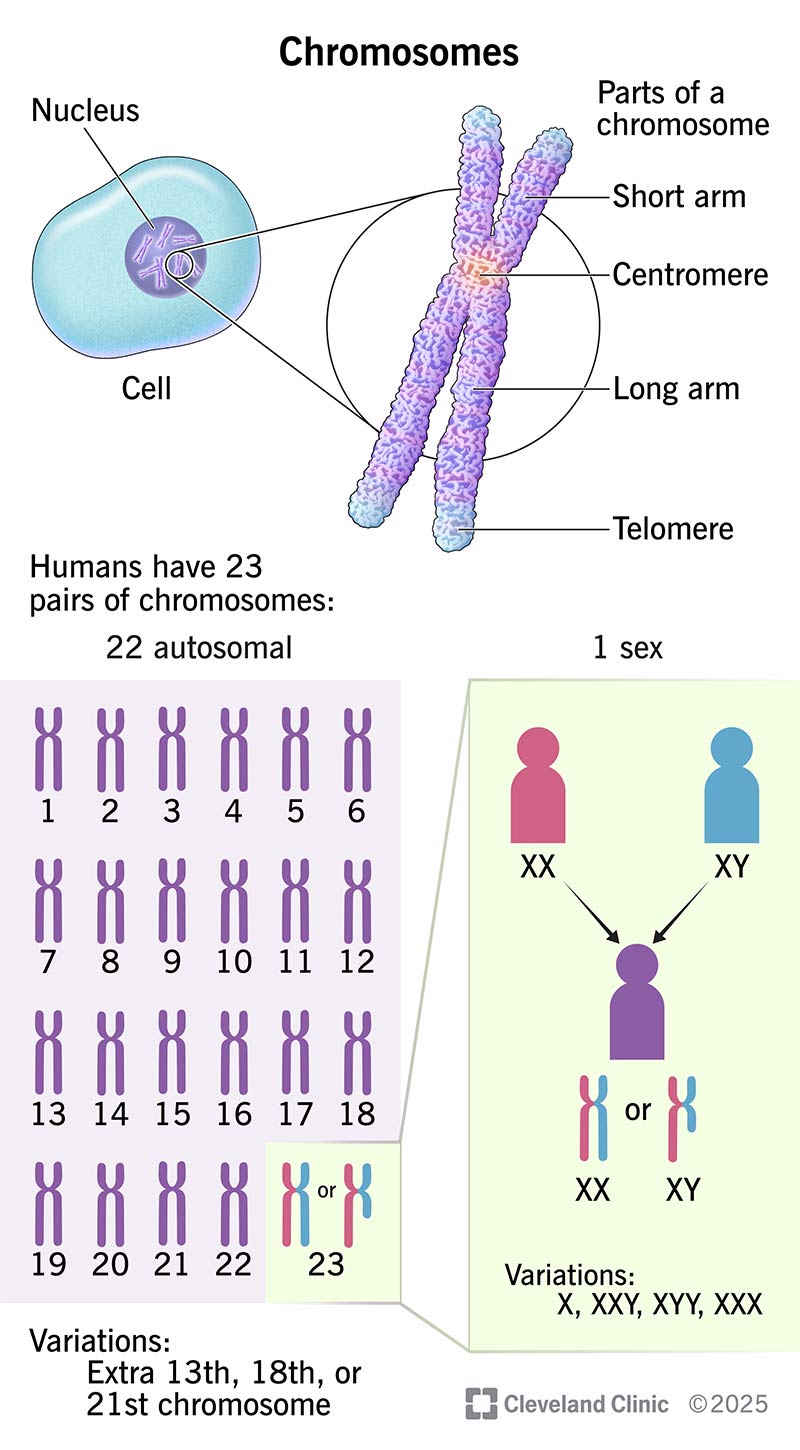Chromosomes are long strings of DNA wrapped around proteins to make them compact. They’re a way for cells to organize and store your DNA. Humans typically have 23 pairs of chromosomes for a total of 46 chromosomes. The first 22 are called autosomes and the last pair are sex chromosomes.
Advertisement
Cleveland Clinic is a non-profit academic medical center. Advertising on our site helps support our mission. We do not endorse non-Cleveland Clinic products or services. Policy

Chromosomes are long strings of DNA (instructions that make your body work), wrapped around special proteins (histones) to make them compact enough to fit into the nucleus of your cells. Your chromosomes are like individual books in your DNA library. Every one of your cells, except red blood cells and platelets, carries copies of your chromosomes.
Advertisement
Cleveland Clinic is a non-profit academic medical center. Advertising on our site helps support our mission. We do not endorse non-Cleveland Clinic products or services. Policy
Like socks or gloves, your chromosomes come in pairs. Humans typically have 23 pairs of chromosomes, for a total of 46 chromosomes. Pairs 1 through 22 are called autosomes. The last pair is called sex chromosomes.
Typically, people have two copies of chromosomes 1 through 22 (autosomes) — you inherit one from each biological parent. Autosomes have anywhere from 750 to 2,800 genes (segments of DNA) on them that give your body the instructions it needs to function.
You generally need two copies of each set of instructions to live. Only in very rare cases can someone survive with only one of any given autosome. Some people have three of certain autosomes (like chromosome 21). But most conditions that cause extra autosomes aren’t survivable.
Sex chromosomes can either be an X or a Y. Everyone gets an X chromosome from their biological mother. Females get an additional X from their biological father. Males get a Y from their biological father. So, your 23rd pair of chromosomes is typically either two Xs or an X and a Y. But some people have:
X is similar to an autosome. It has over 1,000 genes, and you can’t survive without at least one X chromosome. Experts estimate that the Y chromosome has far fewer genes than the X chromosomes or your autosomes. Its main role is in developing the male reproductive system.
Advertisement
Your body deactivates all but one X chromosome in every cell. So, if you have two X chromosomes (or any number more than one), each cell will only carry one active copy. This is called X inactivation or Lyonization. The active X isn’t the same in every cell.
For example, if you have two Xs, your cells will carry the X from both your biological parents. But some cells will have the X from your mother activated and some will have the X from your father activated. The other will be deactivated.
Chromosomes are a way for your body to organize and store DNA. Having two copies of each chromosome ensures that you get the right amount of proteins made by the genes on those chromosomes. This system can also protect you from some diseases. Having an extra copy of every gene on a chromosome means that if something goes wrong with one copy, the other one might be able to cover for it.
If you look at chromosomes under a microscope (they’re too small to see with just your eye), they might look like a squiggly line or a worm. What you’re actually looking at are long strings of DNA wrapped around nucleosomes — or clusters of histones — to make structures called chromatin. The chromatin is then further wrapped around other special proteins to create chromosomes.
Sometimes, you’ll see chromosomes that look like an X. This is a chromosome during cell division, about to make another copy of itself. It has two short arms and two long arms, all connected near the middle. You might see an image of a complete set of chromosomes on an arrangement called a karyotype.
Parts of a chromosome include:
Sometimes, a set of chromosomes may be different in ways that cause health issues. These differences include:
These issues can lead to:
Advertisement
A well-known example of a fusion gene is the “Philadelphia chromosome” (BCR::ABL1 fusion gene), when pieces of chromosome 9 and chromosome 22 break off and change places. This causes certain types of leukemia.
Just like a library is organized and structured into books, your chromosomes organize your DNA. Instead of pieces of paper bound together, your DNA is wrapped around proteins and protected with telomere caps. It’s a handy way for each of your cells to carry all the information they need to tell the story of you.
Advertisement
Do certain health conditions seem to run in your family? Are you ready to find out if you’re at risk? Cleveland Clinic’s genetics team can help.

Last reviewed on 07/07/2025.
Learn more about the Health Library and our editorial process.